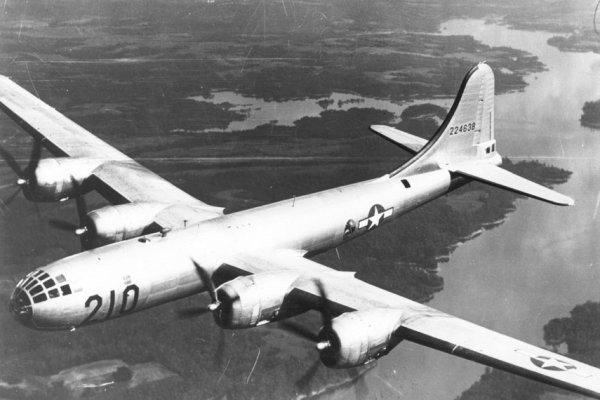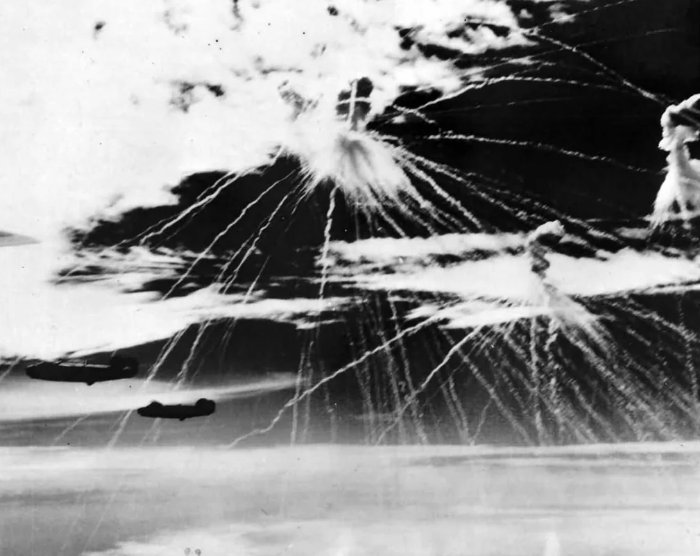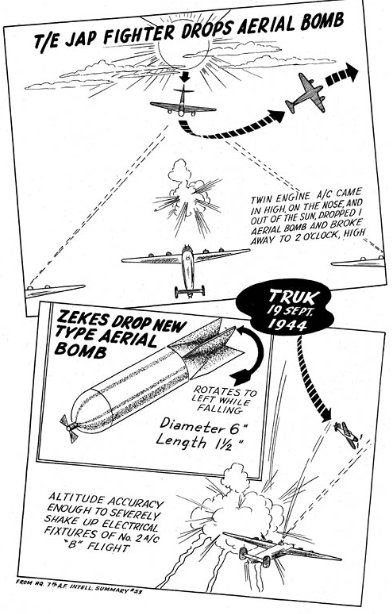ACUFO-1945-06-19-FUKUOKA-1
In the 1990s - 2000s, ufological sources reported that on June 19, 1945, the crew of a B-29, flying over Fukuoka (Japan), observed “a brilliant ball of fire” approaching at very high speed. The B-29 pilot took evasive action while the machine gunners fired. The gunners missed or hit it with no apparent result. The ball of fire was right above them, only fifty meters away, passing right under the bomber. The crew saw no fuselage or wings as it passed under the B-29 and disappeared.
This was said to come from the Tactical Mission Report of June 19-20, 1945, written by the XXIst Bomber Command of the US Army Air Forces.
I found that in the summary report on Operations 210-212, by the XXIst Bomber Command of the XXth Air Force of June 21, 1945, it was reports that...
3 balls of fire sighted. No wings or fuselage observed. One came within 50 yards at very high speed.
This was said to have occurred in the bomb raid by 232 B-29's over Fukuoka on June 19, 1945; in which no B-29 was lost.
| Date: | June 19, 1945 |
|---|---|
| Time: | ? |
| Duration: | ? |
| First known report date: | June 20, 1945 |
| Reporting delay: | Hours. |
| Country: | Japan |
|---|---|
| State/Department: | Fukuoka |
| City or place: | Fukuoka |
| Number of alleged witnesses: | 3 or more. |
|---|---|
| Number of known witnesses: | ? |
| Number of named witnesses: | 0 |
| Reporting channel: | Military operations report. |
|---|---|
| Visibility conditions: | ? |
| UFO observed: | Yes. |
| UFO arrival observed: | Yes. |
| UFO departure observed: | Yes. |
| UFO action: | Passes from above to below the plane. |
| Witnesses action: | Evasive maneuver, machine gun fire with no apparent results. |
| Photographs: | No. |
| Sketch(s) by witness(es): | No. |
| Sketch(es) approved by witness(es): | No. |
| Witness(es) feelings: | ? |
| Witnesses interpretation: | ? |
| Sensors: |
[X] Visual: 3 or more.
[ ] Airborne radar: [ ] Directional ground radar: [ ] Height finder ground radar: [ ] Photo: [ ] Film/video: [ ] EM Effects: [ ] Failures: [ ] Damages: |
|---|---|
| Hynek: | ? |
| Armed / unarmed: | Armed, 12 12.7 mm Browning M2 machine guns. |
| Reliability 1-3: | 2 |
| Strangeness 1-3: | 1 |
| ACUFO: | Possible air-to-air phosphorus bomb. |
[Ref. aaf2:] U.S. ARMY AIR FORCES:

|
21 June 1945.
TWENTIETH AIR FORCE (Cont's.)
XXI BOMBER COMMAND:
OPERATIONS NOS. 210-212, 19 JUNE 1945 (I TIME):
Targets bombed:
| Total A/C Bombing: | 484 |
| TOYAHASHI URBAN AREA | 136 |
| FUKUOKA URBAN AREA | 232 |
| SHIZUKOA URBAN AREA | 133 |
| OTHER TARGETS | 3 |
Time Over Target: 19/2311-20/0318 (I Time).
Bomb Load: 3372.98 tons (46,196 M-47; 8,471 E-46; 40 M-36; 440 E-28; 29 M-17).
Results: Some unobserved, others good to excellent.
Tactics: By radar and visual from an altitude of 7,800 to 8,900 feet.
A/C Lost or Missing: Suzuoka: 2 A/C missing to unknown causes.
Fighter Opposition:
TOYAHASHI: 10-15 E/A sighted. 14 weak, ineffective attacks.
FUKUOKA: 17 E/A sighted, 4 weak and ineffective attacks. 3 balls of fire sighted. No wings or fuselage observed. One came within 50 yards at very high speed.
[Ref. dwn2:] DOMINIQUE WEINSTEIN:
The crew of a B-29, flying over Fukuoka, observed “one bright ball of fire” approaching at a very high speed. The B-29's pilot took evasive action while the machine gunners fired away. The gunners missed, or they hit it with no apparent result. The ball of fire was right on top of them, just fifty yards away, passing right under the bomber. The crew saw no fuselage or any wings as it passed under the B-29 and disappeared.
Sources: Headquarters XXI Bomber Command Tactical Mission Report, June 19/20, 1945, NARA / Strange Company, Keith Chester, 2007.
(Ref. nip1:) "THE NICAP WEBSITE":
June 19, 1945; Fukuoka, Japan
One bright ball of fire; no fuselage or any wings. (Page 180 Ref.1)
The reference 1 is described at the end of the document as “Strange Company (2007), Keith Chester”.
[Ref. tai1:] "THINK ABOUT IT" WEBSITE:
Date: June 19, 1945
Location: Fukuoka, Japan
Time:
Summary: One bright ball of fire; no fuselage or any wings.
Source:
The Boeing B-29 “Superfortress” was the heaviest bomber of the U.S. Army Air Forces, used in operations from May 8, 1944 and on. Its maximum speed was 574 km/h.
Its defensive armament was 12 Browning M2 12.7 mm machine guns.

|

|
The sighting report can be described like this:
The crew of the B-29 observed a bright ball of fire with no fuselage and no wings approaching their plane from above at a very high speed. The pilot took evasive action, while the machine gunners fired and missed or hit the ball of fire with no apparent result, and the ball of fire passed right under the bomber and disappeared.
This is entirely consistent with an air-to-air phosphorus bomb dropped by a Japanese aircraft onto the B-29.
The Japanese pilots did this during many bomb raids over Japan. Japanese planes would fly about 5000 feet above the B-29 and 2000 feet ahead, and drop phosphorus bombs, hoping it would hit the B-29 and set fire to it. The successful hits were very rare.
This explanation implies that it occurred in the night, otherwise the trail would have been seen. It may also have been a malfunctioning air-to-air bomb.
Below: air-to-air phosphorus bombs dropped from Japanese fighter planes to US B-24 bombers on the Pacific theater.

|
Below: sketch of air-to-air phosphorus bombs dropped from a Japanese Mitsubishi “Zero” fighter, from a US intelligence document.

|
Possible air-to-air phosphorus bomb.
* = Source is available to me.
? = Source I am told about but could not get so far. Help needed.
| Main author: | Patrick Gross |
|---|---|
| Contributors: | None |
| Reviewers: | None |
| Editor: | Patrick Gross |
| Version: | Create/changed by: | Date: | Description: |
|---|---|---|---|
| 0.1 | Patrick Gross | December 21, 2023 | Creation, [dwn2], [nip1], [tai1]. |
| 1.0 | Patrick Gross | December 21, 2023 | First published. |
| 1.1 | Patrick Gross | June 6, 2024 | Addition [aaf2]. In the Summary, addition of the information from [aaf2]. |